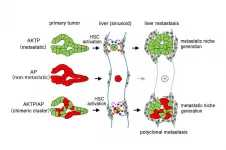(Press-News.org) How much does a power system's reliability depend on the temperature? Electric power system generator resource adequacy modeling is designed to help determine capacity requirements for electric power system operators across the United States. While calculating resource adequacy requirements has been done for a century, it requires ongoing attention as the generation mix is constantly expanding and changing. A new paper contributes to these ongoing reliability considerations by using a unique data set to determine how both low and high temperatures reduce the reliability of coal, gas, diesel, hydroelectric, and nuclear power generators and thus affect the amount of generation markets should contract for.
The paper, "Resource Adequacy Implications of Temperature-dependent Electric Generator Availability," by researchers at Carnegie Mellon University, was published in Applied Energy.
"Our focus is on better understanding the determinants of generator availability and incorporating these considerations into resource adequacy modeling," says Jay Apt, a Professor and Co-Director of the Carnegie Mellon Electricity Industry Center, who co-authored the paper. "Ultimately, this could improve a system operator's ability to determine how much generation is needed when the temperature is very cold or very hot."
The researchers evaluated the PJM Interconnection, the largest electric transmission system operator by installed generation capacity and load in North America, by making use of observed temperature-dependent forced outage rates over 25 years. Current grid resource adequacy modeling assumes that generator failures are unrelated to temperature, though this presents substantial resource adequacy risk. For example, in PJM's case, extreme weather events such as the Polar Vortex cold snap of 2014 added significant stress to the electric grid, suggesting that contrary to prevailing assumptions, generator failures are correlated. Further, assuming unconditional independence can lead to underestimating power system capacity requirements.
The researchers first determined that extreme temperatures, both hot and cold, resulted in less output from PJM's fleet. They then computed capacity requirements for PJM in two different scenarios for a 12-month period in 2018 and 2019. The first represented current practices wherein unconditional independence is assumed, and the second allowed for generator availability to depend on temperature. Additionally, they explored how accelerating changes to the resource mix (i.e.; moving from fossil fuels to solar and wind energy) and future temperature increases under climate change may affect resource adequacy at PJM.
Given the strong seasonality of extreme temperatures, the researchers considered whether monthly procurement targets would help PJM reduce capacity requirements as opposed to the current annual procurement model. They observed the accumulated loss of load expectation (LOLE) - the probability of a blackout due to insufficient power generation - during each calendar month under an annual procurement approach, using both unconditional and temperature-dependent forced outage rates. After accounting for temperature dependence of generator availability, they determined that monthly capacity procurement targets would substantially reduce annual average reserve procurement in PJM with negligible effect on LOLE. This, they explained, is because spring and fall months experience mild temperatures, leading to both lower loads and increased generator availability.
Ultimately, this analysis demonstrates the importance of considering temperature-dependent conditions in resource adequacy modeling. The sort of monthly or seasonal capacity procurement the authors propose could reduce PJM's reserve margin from the 26.6% reserve margin PJM procured in 2018-19 to 22.9%, representing a $315 million annual economic benefit. The authors note that further research is needed to account for the risk of lost load from generator outages during sustained extreme weather events, incorporate demand response resources, quantify operational flexibility needs, and allow system operators to better understand the value of procuring operating reserves.
INFORMATION:
Summarized from "Resource Adequacy Implications of Temperature-dependent Electric Generator Availability," by Murphy, Sinnott (Carnegie Mellon University), Lavin, Luke (Carnegie Mellon University), and Apt, Jay (Carnegie Mellon University). It appears in Applied Energy, Volume 262, March 2020, published by Elsevier.
Copies of this paper are available to credentialed journalists upon request; please contact Elsevier's Newsroom at newsroom@elsevier.com or +31 20 485 2719.
Applied Energy provides a forum for information on innovation, research, development, and demonstration in the areas of energy conversion and conservation, the optimal use of energy resources, analysis and optimization of energy processes, mitigation of environmental pollutants, and sustainable energy systems. The journal publishes original papers, review articles, technical notes, and letters to the editor.
Authors are encouraged to submit manuscripts that bridge the gaps between research, development, and implementation. The breadth of coverage ranges from innovative technologies and systems of both fossil and renewable energy to the economic industrial and domestic use of energy with no or minor impact on the environment. Applied Energy is also concerned with the attendant problems of modeling and forecasting, conservation strategies, and the environmental, social, and economic impacts of energy policies and usage, including climate change mitigation and other environmental pollution reduction.
In a courtesy call to HE the President of Malta at San Anton Palace on Thursday, February 11, 2021, Dr Noel Aquilina from the Department of Chemistry, accompanied by Professor Emmanuel Sinagra, Head of the Department of Chemistry and Dean of the Faculty of Science at the University of Malta, presented the findings of a landmark study. This study shows and confirms that airborne particulate matter (PM), apart from several toxic components, is also contaminated with tobacco smoke-driven particulates.
After 30 years, Dr Noel Aquilina, alongside world renowned tobacco smoke-related researchers, ...
The Internet has revolutionized our lives - whether in terms of working, finding information or entertainment, connecting with others, or shopping. The online world has made many things easier and opened up previously unimaginable opportunities. At the same time, it presents both individuals and societies with major challenges: The underlying technologies do not necessarily serve users' best interests.
"We're interested in questions such as: How can we create online environments that respect human autonomy and promote truth? And what can people themselves do to avoid being ...
An international team of scientists has determined how harmless E. coli gut bacteria in chickens can easily pick up the genes required to evolve to cause a life-threatening infection. Their study, published in Nature Communications, warns that such infections not only affect the poultry industry but could also potentially cross over to infect humans.
E. coli is a common bacterium that lives in the intestines of most animals, including humans. It is usually harmless when it stays in the gut, however it can become very dangerous if it invades the bloodstream, causing ...
"We are surrounded by a huge number of systems - biological, technical, economic, which we can influence, which we can control. The task is to do it optimally, for example, reaching the desired point with a minimum of effort, resources, and time, - explains Prof. Yurii Averboukh. - From a mathematical point of view, the task is narrowed down to the theory of optimal control. A classic example of this theory is moon landing: fuel consumption optimization enables to increase cargo volumes transported to the moon".
A special section of optimal control theory is the theory of differential games. It studies the control ...
Sophia Antipolis, 12 February 2021: An active lifestyle is linked with a lower chance of dying immediately from a heart attack, according to a study published today in the European Journal of Preventive Cardiology, a journal of the European Society of Cardiology (ESC).1
Heart disease is the leading cause of death globally and prevention is a major public health priority. The beneficial impact of physical activity in stopping heart disease and sudden death on a population level is well documented. This study focused on the effect of an active versus sedentary lifestyle on the immediate course of a heart attack - an area with ...
A study has now been presented that boosts the evidence for using AI solutions in skin cancer diagnostics. With an algorithm they devised themselves, scientists at the University of Gothenburg show the capacity of technology to perform at the same level as dermatologists in assessing the severity of skin melanoma.
The study, published in the Journal of the American Academy of Dermatology, and its results are the work of a research group at the Department of Dermatology and Venereology at Sahlgrenska Academy, University of Gothenburg.
The study was conducted at Sahlgrenska University ...
Novel genetic associations could pave the way for early interventions and personalized treatment of an incurable condition.
Scientists from the University of Bergen (Norway) and Karolinska Institutet (Sweden) have discovered the genes involved in autoimmune Addison's disease, a condition where the body's immune systems destroys the adrenal cortex leading to a life-threatening hormonal deficiency of cortisol and aldosterone.
Groundbreaking study
The rarity of Addison's disease has until now made scanning of the whole genome for clues to the disease's genetic origins difficult, as this method normally requires many thousands of study participants. However, by combining the world's two largest ...
Tumor cells are able to avoid the attack of the immune system through several mechanisms. For instance, these can secrete factors that turn macrophages -cells in the immune system- into dual action agents that contribute to the tumor progress and will protect it from immune body defences: these become, thus, the tumor-associated macrophages (TAMs).
An article published in the journal Cancer Research describes a new molecular mechanism that counteracts the immunosupressive action of these macrophaes to boost tumor growth, and brings knowledge of potential interest for the design of future therapeutical options against cancer. The preclinical study is led by the tenure-track 2 lecturer Annabel Valledor, from the Faculty ...
Most tumors consist of a heterogenous mix of cells. Genetic mutations found only in some of these cells are known to aid with the spread and progression of cancer. However, oncologists often find that when tumors metastasize to distant organs, they retain this heterogenous nature--a phenomenon termed "polyclonal metastasis". The mechanism by which non-metastatic cells accompany the metastatic cells is ambiguous. Now, Masanobu Oshima and his research team have used mouse models to explain how non-metastatic cells begin their long commute.
The team has previously developed various cancerous mutants of mice and analyzed ...
New research shows that hurricane maximum wind speeds in the subtropical Atlantic around Bermuda have more than doubled on average over the last 60 years due to rising ocean temperatures in the region.
Hurricanes intensify by extracting energy from the warm ocean surface via air-sea heat fluxes, so a warmer ocean can lead to more intense hurricanes.
Improving predictions of wind speeds from hurricanes will help determine the right level of response in advance of the storm and potentially limit the resulting damage in Bermuda.
Between 1955 and ...





